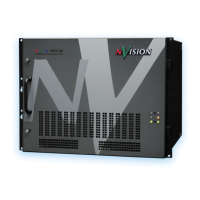NV5128 Multi-Format Router • User’s Guide 3
2. Introduction
Chapter 2 provides a functional description of the product. It presents these topics:
• Product Summary
• Power Supply
• Signals Types and Rates
• Switching Configurations
• Module Slots and Rear Connectors
• Active Cards
Product Summary
The NV5128 Multi-Format Router is a highly flexible router supporting audio and video signals,
both analog and digital, in a variety of combinations. (See Signals Types and Rates
on page 5.) The
router can support up to 128 inputs and 128 outputs (256 inputs and 256 outputs mono), typically
organized in a block of 16 inputs and 16 outputs, expandable in increments of 16. A fully non-
blocking matrix architecture, allows for one-to-one and one-to-many routing.
For audio signals, the NV5128 routes stereo signals internally as mono channels, enabling the
recombination of channels to create new stereo signals. Analog audio signals are routed internally
as digital signals. Converters housed on I/O cards convert incoming analog signals to digital and
outgoing digital signals to analog as needed.
For video signals, the router can manage Standard Definition (SD) separately, or SD and High Def-
inition (HD) signals combined, referred to as Super Wide Band (SWB). Analog video signals are
routed internally without being converted to digital. However, an Analog Video Converter (AVC)
card is available for the conversion of analog to digital and digital to analog.
Additionally, longitudinal time code signals and machine control signals can also be routed within
the same frame enabling you to meet unique switching needs.
Active input cards, output cards, and control cards are “hot swappable” and installed through the
front of the frame for easy access. The rear of the router features a back plate into which backplanes
housing different types of connectors for receiving and distributing signals are installed. Each back-
plane receives or distributes signals for a single active card allowing for maximum switching con-
figuration flexibility: backplanes are not pre-installed in pre-selected router slots. The back plate
also contains connections to system functions, such as a router control system, alarms or reference
signals.

